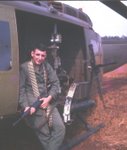3/6/08
The "O" Club
The Officers Club, “The O Club” was the main focal point of off duty and some on duty activities. Although common military protocol prevailed, rank became less significant at the club. This was especially true during parties- planned and unplanned, and it seemed like the more alcohol that was consumed the more the playing field was leveled.
All decorated for Christmas so this is right at the end of my tour in 68.
Off duty attire was pretty well left up to the individual and ranged from standard jungle fatigues, flight suits and any variation of civilian clothes you could imagine. Foam rubber “flip-flops” and “Ho Chi Minh’ sandals, (made from worn out tires) were popular foot wear.
After a day of flying we would go to the mess hall for a meal, get a quick shower and usually migrate to the club. We recounted the day’s missions and embellished openly. Tactics and lessons learned were exchanged and informal critiques of pilots that had not yet been promoted to aircraft commander were discussed discretely, one on one. (Pilots not yet promoted to aircraft commander were referred to as a “Peter Pilot”.)
Here, Pat Teague makes a point!
There always seemed to be an improvement project of some sort going on at our club. Bare incandescent bulbs were replaced by fluorescents, spotlights controlled by rheostats to light the stage were installed and the bare concrete slab floor was tiled with linoleum.
Nearly all officers’ clubs had a bell hung above the bar and ringing it signified all sorts of tradition inspired activities or that the person doing the ringing wanted everyone’s attention to make an announcement. Ultimately, the bell ringing resulted in more of whatever you were drinking, being placed in front of you. Some of the “traditions” I can recall included: “Hat on the bar, buys the bar.” (We had hat racks by the doors of the club.) “First Air Medal buys the bar.” (The requirement for award of the Air Medal was actually based on accumulation of combat flight time but I can’t remember the specifics involved.) All of us went home with the Air Medal covered with a row of “Oak Leaf Clusters” that signified multiple awards of the same medal. If you belched or broke wind loudly and noxiously, you bought the bar. Boasting about your flying heroics caused you to buy the bar. Being promoted to A/C, (Aircraft Commander) caused you to buy the bar. The list went on and was modified according to the level of festivity and the proximity to pay day. (Pay Call.) Of course, being promoted in grade, (rank) called for a huge celebration and usually resulted in the promoted individual low crawling or getting carried back to his “hooch”.
I think the price of a 1-1/2 ounce mixed drink was 30 cents and beer was 15 or 20 cents a can or bottle. The beer of choice was “San Miguel” from the Philippines. American beer was available most of the time but the supply and variety seemed to vary. There was a Vietnamese beer called “Ba Moui Ba" we drank when really desperate and was rumored to have been made with formaldehyde. As you can see from the pictures of the bar supplied by Dennis Ragan, we didn’t lack hard liquor a bit. We even had an ice making machine.
All girl band,probably from Tailand. This is Col. Mierswa's going away celebration.
I’m not certain who was responsible for contracting entertainment, (probably the USO) but we had “shows” from time to time. They came from the Philippines, Australia, Japan and even a few from the United States. All girl bands were popular and several pictures below show one such group. The Asian groups did a pretty good job of doing current music, all things considered, but it was a culture shock to see an oriental band all dressed up in cowboy regalia performing country music for us. Prior to my arrival in the Nam, strip shows were popular but were strictly forbidden at some point. During my entire tour, I never saw one.
The officers club took you out of the Nam briefly and provided an outlet for the frustrations and tensions we all felt. We “bonded” there and saw another aspect of our fellow aviators.
Subscribe to:
Post Comments (Atom)









2 comments:
That going away party was such a joyous occasion for warrants that we drank all the cold champagne and started in on the warm champagne. The higher-ranking officers had a table at the front, so it was fairly easy when opening champagne to aim the cork so it hit the ceiling and bounced into the high officer table. For pilots, this was easy.
The next day, I got shot down.
Yeah, Miles Mierswa was a real piece of work. I flew with him once right after I got in country but it was a short flight. I never turned the inverters on during pre-flight so the fuel quantity wasn't known until we soon noticed how low it was after we launched. You can bet the CE and gunner knew though! I dropped Miles off at the "hot spot" and went for fuel and they were giggling insanely. Oh well, Miles WAS the AC and all that stuff was his responsibility.
Post a Comment